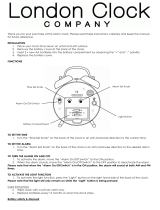Radio-controlled projection clock with thermometer
1312
Radio-controlled projection clock with thermometer
Left side (Fig. 3)
O: “CONTINUE PROJECTION” switch
P: Power socket
Top (Fig. 4)
Q: “SNOOZE/LIGHT“ button
6. Getting started
• The projection clock is powered by 2 x 1.5 V AA batteries. To use the projection function,
please utilize the mains adapter supplied.
• Insert the adapter into the jack. Connect the power adapter to a wall socket. The unit is
now ready to use.
• Important!
Make sure that your household voltage is 230V! Otherwise your clock may be damaged.
• Open the battery compartment and remove the insulation strip.
• A brief beep tone will sound and all LCD segments will light up for about 2 seconds.
• Close the battery compartment again.
• The clock will scan the DCF frequency signal and the DCF symbol flashes on the LCD.
When the signal is received successfully after 3-5 minutes, the radio-controlled time and
the DCF symbol appear permanently. The clock automatically scans the time signal every
hour to maintain accurate timing.
• In Daylight Saving Time “S” is shown on the LCD.
• If the reception fails, activate the reception manually by holding “WAVE” button for
2 seconds.
• The wave display shows the signal receiving status:
Normal reception status
Weak signal
• In case the clock cannot detect the DCF-signal (for example due to disturbances, transmit-
ting distance, etc.), the time can be set manually. The clock will then work as a normal
quartz clock. (see 7.1 Setting of clock and calendar).
Radio-controlled time reception
The time base for the radio-controlled time is a Caesium Atomic Clock operated by the
Physikalisch Technische Bundesanstalt Braunschweig which has a time deviation of less than
one second in one million years. The time is coded and transmitted from Mainflingen near
Frankfurt via frequency signal DCF-77 (77.5 kHz) and has a transmitting range of approxi-
mately 1,500 km. Your radio-controlled clock receives this signal and converts it to show the
precise time in summer or wintertime. The quality of the reception depends greatly on the
geographic location. In normal cases, there should be no reception problems within a 1,500
km radius around Frankfurt.
Please take note of the following:
• Recommended distance to any interfering sources like computer monitors or TV sets is a
minimum of 1.5 - 2 metres.
• Within ferro-concrete rooms (basements, superstructures), the received signal is naturally
weakened. In extreme cases, please place the unit close to a window and/or point its
front or back towards the Frankfurt transmitter.
• During night-time, the atmospheric disturbances are usually less severe and reception is
possible in most cases. A single daily reception is adequate to keep the accuracy devia-
tion below 1 second.
7. How to operate
7.1
Manual setting of clock and calendar
• Hold “MODE” button for 3 seconds in normal mode (time/ temperature display). The year
digit is flashing. Press “▼“ or “▲“ buttons to adjust the year. Holding “▼“ or “▲“ but-
tons, you will enter fast mode.
• The setting sequence is shown as follow: Year, Month, Day, Hours, Minutes. Press “▼“ or
“▲“ buttons to make the desired settings.
• The instrument will quit the setting mode, if there is no button used within 30 seconds.
• The manually set time will be overwritten by the DCF time when the signal is received
successfully
• Press “▲“ button to choose 12 HR or 24 HR system.
7.2 Day-of-week language
• Press “▼“ or “▲“ buttons to choose weekday or week number display.
• Press and hold “▼“ button. Language abbreviations change from one language to
another: English (EN), German (DE), French (FR), Italian (IT), Spanish (SP).
7.3 Setting °C/°F
• Press the “WAVE” button to change in normal mode between °C (Celsius) or °F (Fahren-
heit) as temperature unit.
7.4 Setting of time zone
• The time zone is used for the countries where the DCF signal can be received but the
time zone is different from the DCF time.
• Hold “▲“ button for 2 seconds in normal mode (time/temperature display). “F” appears
on the display. Hold “MODE” button for 2 seconds. The hour digit is flashing. Press “▼“
or “▲“ button to adjust hours to your local time.
7.5 Alarm setting
• Select your desired alarm by “MODE” button:
1. Alarm 1: AL 1
2. Alarm 2: AL 2
• Set the alarm time in the desired alarm mode. Hold “MODE” button for 3 seconds. The
hour digits are flashing. Press “▼“ or “▲“ button to adjust the time. Confirm with
“MODE” button. Set minutes in the same way. Confirm with “MODE” button and the
alarm is activated.
• To activate or deactivate the alarm function press “ALARM” button. , , +
or no alarm symbol is shown on the LCD.
• Once the alarm starts to ring, you can stop the alarm by pressing “ALARM” button.
• You can activate the snooze function by pressing the “SNOOZE/ LIGHT” button on the
top. Zz appears and the alarm will be interrupted for 4 minutes.
TFA_No. 98.1085_Anleit_11_12 23.11.2012 14:23 Uhr Seite 7






